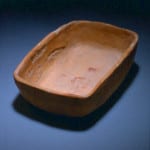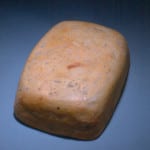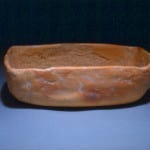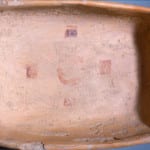Hopi rectangular ceremonial bowl, circa 1870s to early 20th century. This pot has been “used by (a) Hopi woman in her home to hold ceremonial items.” (Source comments by Richard Howard, from whom I purchased the bowl.)
The bowl is unslipped yellow ware with an undecorated exterior; the only decoration on the interior is a worn red design 3 inches by 2.7 inches consisting of a central 1-inch diameter circle orbited by four small red squares. A production date of the 1870s is only an informed guess by Dick Howard, but the unusual rectangular shape, undecorated exterior, and simple interior design conform to the elements of ceremonial pots described by Suzanne G. Kenagy (1990). If it does date to the 1870s, it is also an unusual example of unslipped yellow ware from a time when most Hopi ceramics were produced at Polacca using a white-slipped style. In a June 7, 1993 appraisal [on file], Rick Dillingham writes that the bowl is “Casually constructed in grey (fires yellow) clay with faint design in the center with 5 elements. Chips, cracks, etc. Ca. early 20th C.? Square bowls are common in ceremonial use among the Hopi/Tewa but do not reach the marketplace often.”
Fewkes (1898, plate CXXVIII following page 668 or reprinted, 1973: 44 ff) illustrates a “medicine box” (“c”) from Sikyatki which is of similar shape but decorated on the exterior. Fewkes (1898, 681 or 1973 reprint 57) writes about this bowl that the “several (Sikyatki) rectangular receptacles of earthenware” he excavated “are regarded as medicine bowls, and are supposed to have been used in ancient ceremonials where asperging was performed. In many Tusayan ceremonials square medicine bowls, some without handles, are still used, but a more common and evidently more modern variety are round and have handles.” Fewkes then references a “rectangular or ancient type of medicine bowl” used on the Antelope clan altar for the snake dance at Oribi (Third Mesa).
Without attribution, Fewkes may be referring to a published account of a snale dance at Mishongnovi (Second Mesa) whitnessed by H. R. Voth (of Orabi) and Grorge A. Dorsey in June 1902 (Dorsey and Voth, 1976: 159-261). Dorsey writes:
“Sikangpu (a Snake Priest) now took a small red medicine bowl which he half filled with water…..and (sat) down near the fireplace (in the kiva)…The medicine bowl itself, it may be here remarked, was dull reddish in color without visible decoration, about six inches in diameter and was not provided with a handle. On inquiring of the priest if this was the original bowl for this ceremony, the reply was that the flat, squarish bowl with a rain cloud terrace on each side which is the usual medicine bowl of Hopi ceremonies, had probably long ago been broken and replaced by this more simple bowl. At any rate, this was the only medicine bowl which he, the chief priest,had ever known for this ceremony.” (1976:206)
For an example of a modern (1922) rectangular prayer meal bowl by Maria Martinez of San Ildefonso, see fig. 165 in Peckham (1990:130 and 154). Perhaps coincidentally Fewkes (1973:160-162) also discusses the pahoki or prayer-stick houses (still seen at Schomovi) as flat stone slabs set up to form open boxes to shelter the prayer feathers. According to Fewkes, such shrine houses are drawn as rectangular images on Sikyatki bowls, all of which is to say that this is either Bahana speculation or that the rectangular shape of this bowl is compatible with a Hopi sense of sheltering the sacred. Two Hopi medicine bowls of rectangular shape but with terraced edges are part of the collection (2005-17 & 2005-18). For a modern Hopi prayer bowl by L. Shula, see 2000-01.





